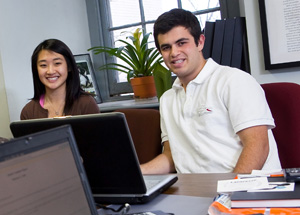Jordan Kaplan ’10 writes about planning a local art and cultural center
 Jordan Kaplan ’10 (Livingston, N.J.), an economics and business major, is project leader for the College’s Economic Empowerment and Global Learning Project’s revitalization efforts in Easton. Working under the guidance of Gladstone Fluney Hutchinson, associate professor of economics, the team has been working closely with residents of Easton to study the economic feasibility of transforming the city’s Governor Wolf building into a community center for arts and cultural activities.
Jordan Kaplan ’10 (Livingston, N.J.), an economics and business major, is project leader for the College’s Economic Empowerment and Global Learning Project’s revitalization efforts in Easton. Working under the guidance of Gladstone Fluney Hutchinson, associate professor of economics, the team has been working closely with residents of Easton to study the economic feasibility of transforming the city’s Governor Wolf building into a community center for arts and cultural activities.
Over the course of the last year, I have been fortunate enough to work with Professor Fluney Hutchinson and a very talented group of students to produce a study that examines the economic and social benefits of an art and culture center in downtown Easton. This project has been an excellent opportunity for me to work with a team that combines several areas of study at Lafayette to investigate the issue at hand.
As project leader, I am responsible for overseeing all aspects of the project and making sure that our team has examined the question from all angles. I truly believe we were able to address the question, “Can an art and culture athenaeum in the Governor Wolf building be self-sustaining and serve as a platform for the economic renewal and development of the City of Easton?”
As an economics and business major, my specialty was addressing the idea of externalities and how new economic activity brought into Easton by an art and cultural center impacts several sectors of local government. Using input-output models, we were able to determine the effects on 177 sectors of the local economy in terms of economic output, new employment opportunities created, indirect business taxes, and more.
In addition to producing a successful report, this project represents much more than a study of art and culture’s impact on the local community. Mayor Sal Panto, Northampton County Executive John Stoffa, and many other members of local government were extremely supportive of our research. I believe that the success of the Governor Wolf project has opened the door for further collaboration between the college and local government. Using this collaboration, we were able to produce a project that is much greater than any individual group could produce alone.
Using the collaborative efforts of the college, local government, and community mentors, we have developed a framework which will help future EEGLP teams produce excellent and accurate work beyond the Governor Wolf project. Currently, the framework is being applied to EEGLP’s Louis Armstrong Building project in New Orleans, which has goals similar to those of the Governor Wolf project.
On a more personal note, this project has greatly influenced my honors thesis, which is exploring the economic benefits of the town-gown relationship. After working collaboratively with the Easton city government, I have been inspired to further explore how the externalities from civic engagement at colleges and universities affect the local economy.
Outside the Governor Wolf Project and EEGLP, I am a national officer for the Phi Kappa Psi Fraternity, and I work with the Easton Boys and Girls Club and am currently developing the “Money Matters Program,” which teaches kids about creating a business and basic personal finance. Next year, I plan on attending law school. I have been accepted to Seton Hall Law and Rutgers Law, though I am still making my final decision.
 Jordan Kaplan ’10 (Livingston, N.J.), an economics and business major, is project leader for the College’s Economic Empowerment and Global Learning Project’s revitalization efforts in Easton. Working under the guidance of Gladstone Fluney Hutchinson, associate professor of economics, the team has been working closely with residents of Easton to study the economic feasibility of transforming the city’s Governor Wolf building into a community center for arts and cultural activities.
Jordan Kaplan ’10 (Livingston, N.J.), an economics and business major, is project leader for the College’s Economic Empowerment and Global Learning Project’s revitalization efforts in Easton. Working under the guidance of Gladstone Fluney Hutchinson, associate professor of economics, the team has been working closely with residents of Easton to study the economic feasibility of transforming the city’s Governor Wolf building into a community center for arts and cultural activities.